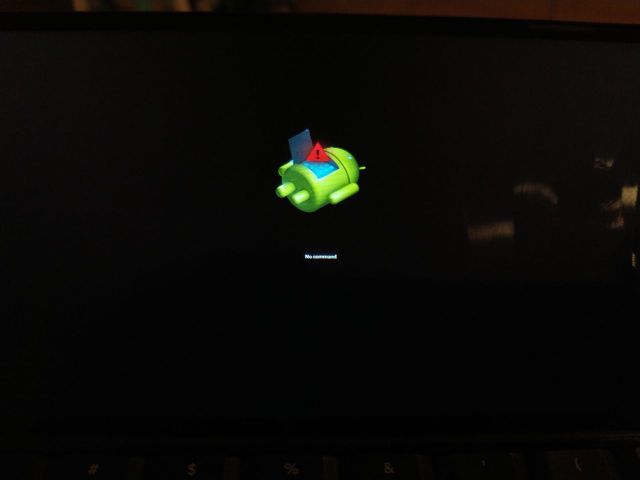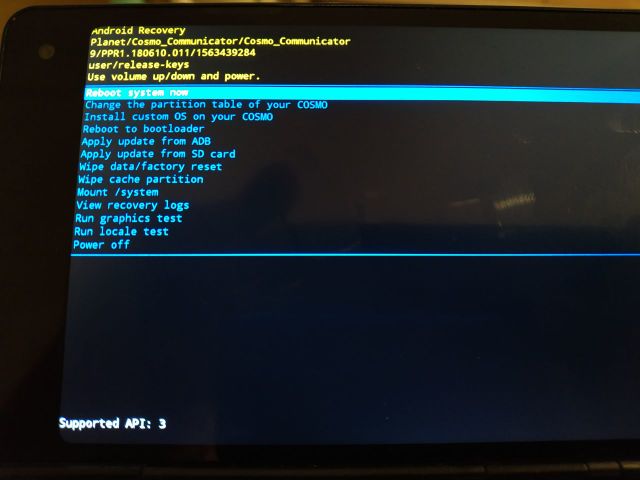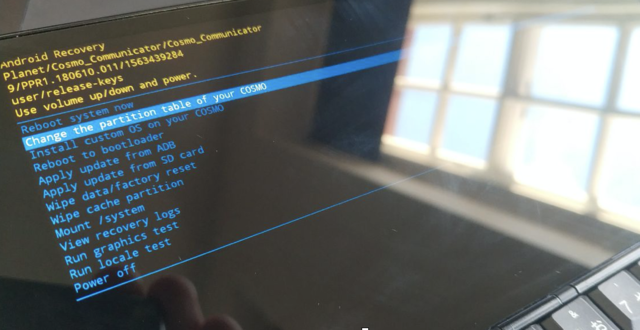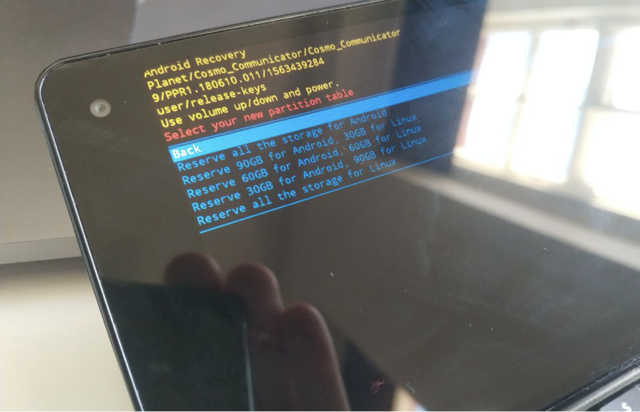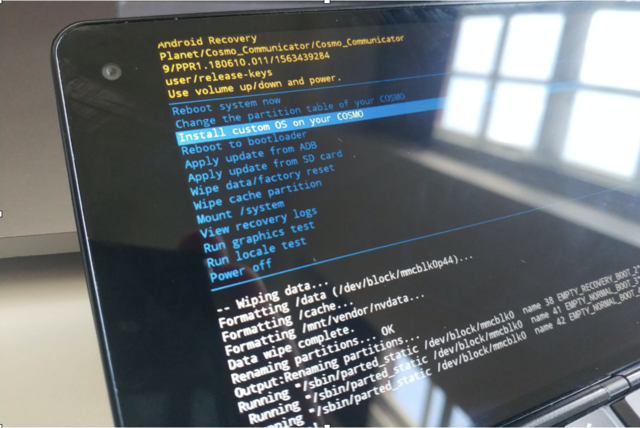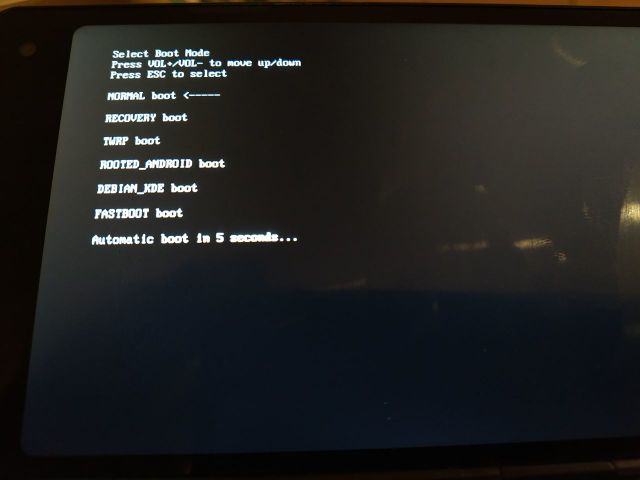Difference between revisions of "Cosmo Android Firmware Manual Installation"
From Planet Computers
(Created page with "==Android Cosmo Firmware Update - Manual Installation== Using this guide you can manually install a specific Android version for your Cosmo Communicator. You can download the...") |
|||
| Line 2: | Line 2: | ||
Using this guide you can manually install a specific Android version for your Cosmo Communicator. | Using this guide you can manually install a specific Android version for your Cosmo Communicator. | ||
| − | You can download the | + | You can download the available Android firmware archive below: |
* [http://support.planetcom.co.uk/download/cosmo-customos-installer.zip http://support.planetcom.co.uk/download/cosmo-android-v19.zip] (MD5: 4cfe693455042b4479e6638ba005f3d3) | * [http://support.planetcom.co.uk/download/cosmo-customos-installer.zip http://support.planetcom.co.uk/download/cosmo-android-v19.zip] (MD5: 4cfe693455042b4479e6638ba005f3d3) | ||
| Line 25: | Line 25: | ||
| − | + | To be able to install a specific Android version you need to partition your device to accept custom OS. In order to do this you will have to re-partition your device, which will lead to the loss of all your data. If you already have partition your device you don't need to do it again. | |
| + | |||
| + | To change the partition table of your Cosmo use the option "Change the partition table of your COSMO", as in the picture below. | ||
[[File:Screenshot_2020-02-12_at_15.12.52.png|center|640x330px|border]] | [[File:Screenshot_2020-02-12_at_15.12.52.png|center|640x330px|border]] | ||
| Line 55: | Line 57: | ||
| − | This option will scan the microSD card for compatible installers and | + | This option will scan the microSD card for compatible installers and it should find one or more, for example: |
| − | |||
| − | |||
| − | |||
| − | + | * Reinstall Android V19 (Factory Reset) | |
| − | + | Select the appropriate OS and press the Enter key. If you see a screen asking to select where to install the custom OS (for example in EMPTY_RECOVERY_BOOT_2, EMPTY_NORMAL_BOOT_3 or EMPTY_NORMAL_BOOT_4), just select any available option and press Enter again. The Android firmware will overwrite the standard Android and will not affect any other custo OS that you might have installed. | |
| − | |||
| − | |||
| − | |||
| − | + | After the installation is completed, reboot the unit. A boot menu will then appear when you turn ON the device, allowing you to choose what to start as in the following picture. | |
| − | |||
| − | |||
| − | |||
| Line 77: | Line 70: | ||
| − | + | After the Android firmware installation you can repartition your Cosmo to only store Android and regain the space used by Linux, if you want to. | |
| − | |||
| − | |||
| − | |||
| − | |||
| − | |||
| − | |||
| − | |||
| − | |||
| − | |||
| − | |||
| − | |||
| − | |||
| − | |||
| − | |||
| − | |||
| − | |||
| − | |||
| − | |||
| − | |||
| − | |||
| − | |||
| − | |||
| − | |||
| − | |||
| − | |||
| − | |||
| − | |||
| − | |||
| − | |||
| − | |||
| − | |||
| − | |||
| − | |||
| − | |||
| − | |||
| − | |||
| − | |||
| − | |||
| − | |||
| − | |||
| − | |||
| − | |||
| − | |||
| − | |||
| − | |||
Revision as of 17:02, 21 April 2020
Android Cosmo Firmware Update - Manual Installation
Using this guide you can manually install a specific Android version for your Cosmo Communicator.
You can download the available Android firmware archive below:
- http://support.planetcom.co.uk/download/cosmo-android-v19.zip (MD5: 4cfe693455042b4479e6638ba005f3d3)
Once you downloaded the zip archive you will have to extract its content onto your microSD card:
- Open Files by Google and locate the ZIP archive
- Tap the file to reveal the cosmo-customos-installer folder
- Long tap on that folder, select Extract to... and finally select the microSD card as destination. Your microSD card should now contain a folder named cosmo-customos-installer with several files inside it.
Next, you will have to boot into recovery mode. To do that, simply turn ON your Cosmo while keeping pressed the volume up button on the outside cover. The volume up button is the one on the fingerprint sensor, which points UP when the unit is open. The unit should boot into recovery mode and you should be able to see the Android logo, but nothing else - as in the following screenshot.
At this point, keep the ESC key pressed (top left key on the keyboard) and press the volume up button from the outside cover again, then release both keys. This following menu will be displayed.
To be able to install a specific Android version you need to partition your device to accept custom OS. In order to do this you will have to re-partition your device, which will lead to the loss of all your data. If you already have partition your device you don't need to do it again.
To change the partition table of your Cosmo use the option "Change the partition table of your COSMO", as in the picture below.
You will have 5 options to choose from:
- Reserve all space for Android
- Reserve 90GB for Android and 30GB for Linux
- Reserve 60GB for Android and 60GB for Linux
- Reserve 30GB for Android and 90 GB for Linux
- Reserve all space for Linux
If you select to reserve some space for Linux, 4 additional partitions will be created:
- EMPTY_RECOVERY_BOOT_2 - This partition can be used to store an image that runs in recovery mode, such as TWRP
- EMPTY_NORMAL_BOOT_3 - This partition can be used to store Debian/KDE or Rooted Android
- EMPTY_NORMAL_BOOT_4 - This partition can be used to store Debian/KDE or Rooted Android
- In addition, an extra partition will be created with the custom size selected by the user, which will be used to store the root file system.
Once the storage for Linux has been reserved, you can install a custom OS on your Cosmo, by choosing the related option as in the picture below.
This option will scan the microSD card for compatible installers and it should find one or more, for example:
- Reinstall Android V19 (Factory Reset)
Select the appropriate OS and press the Enter key. If you see a screen asking to select where to install the custom OS (for example in EMPTY_RECOVERY_BOOT_2, EMPTY_NORMAL_BOOT_3 or EMPTY_NORMAL_BOOT_4), just select any available option and press Enter again. The Android firmware will overwrite the standard Android and will not affect any other custo OS that you might have installed.
After the installation is completed, reboot the unit. A boot menu will then appear when you turn ON the device, allowing you to choose what to start as in the following picture.
After the Android firmware installation you can repartition your Cosmo to only store Android and regain the space used by Linux, if you want to.


